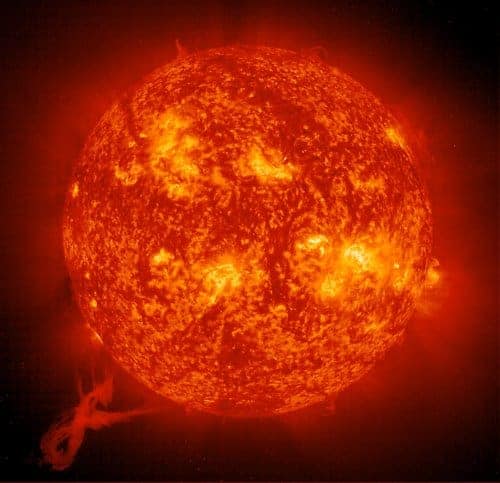
If you think the weather on Earth is unpredictable, on the Sun it is far more puzzling. For decades scientists have wondered how its corona — or outer atmosphere — can be so much hotter than its surface, even though they are thousands of kilometres apart. Then there is the question of what powers solar flares, which can shower satellites and astronauts with lethal radiation.
If the logic is correct, then we should have a good chance to directly see solar axions, or axions made in the laboratory by ourselves Konstantin Zioutas, CERN
Now a group led by Konstantin Zioutas at CERN thinks the answer might lie with the “axion”, a hypothetical particle that could also explain the mysterious dark matter that seems to make up most of the universe’s mass. “If the logic is correct, then we should have a good chance to directly see solar axions, or axions made in the laboratory by ourselves,” says Zioutas.
New light on an old theory
Axions were first proposed in the late 1970s to solve an issue in particle physics known as the strong-CP problem. Theory said they would be light with weak interactions — properties that also made them attractive for dark matter. However, despite many experimental searches, evidence for the particles has been thin on the ground.
If axions do exist, physicists think they would be generated in the Sun. The original idea was that microscopic electric fields would convert thermal X–ray photons in the Sun’s hot core into axions, which would then travel outwards. At some point near the surface, magnetic fields would convert them back into X-ray photons, thereby transfering heat from the core to corona. The X–rays could even trigger solar flares.
But although this mechanism would explain the corona’s high temperature at magnetized places, observations show that the Sun does not only emit X–rays radially, as would be expected if they had taken a straight path from their point of conversion. Instead, X–rays seem to come from the surface at all angles. Another problem is that the X–rays ought to have a “black-body” spectrum that peaks at kilo electron volt (keV) energies, whereas in fact the spectrum is more befitting of a power law with no keV peak.
Scattered X–rays
Zioutas’s group thinks it can reconcile axions with such observations. Last year the researchers put forward the beginnings of an idea in which some of the X–rays beneath the surface ionize surrounding matter. The liberated electrons from this ionization would then scatter subsequent X–rays while reducing their energy, causing them to leave the surface in all directions and with a power-law spectrum.
In the researchers’ latest study, “Monte Carlo” computer simulations show that this mechanism could be satisfied by an axion with a mass in the region of 0.02 eV. This type of axion is too light to be detectable with present experiments, though if it does exist it could still serve as a solution to the strong-CP problem, and as a form of “hot” dark matter.
However, the proposal is being met with scepticism by some particle physicists. Aaron Chou, a physicist at Fermilab in the US, says that he has discussed it with Zioutas, but finds it too “unrealistic” to work. “The multiple scattering needed to randomize the directions of the axion–induced X–ray flux destroys the coherence of the process converting axions to X–rays in the first place,” he explains.
“The two requirements of his model — efficient coherent conversion and subsequent randomization of trajectories — appear to be mutually contradictory in that they cannot be simultaneously satisfied, at least not within the context of this model,” he adds.
Upgraded experiment
Zioutas admits that his group’s model has shortcomings, such as the fact that it cannot explain the full intensity of the solar X–rays. Nevertheless, he and Andrzej Siemko, also from CERN, have put in a proposal to CERN management for a more sensitive version of CAST, the present experiment at the European lab that searches for axions leaving the Sun by trying to convert them back into photons in a magnetic field.
The upgrade, which would employ one or two of the spare quadrupole magnets from the Large Hadron Collider and which would cost an estimated CHF 250,000 (£140,000), should be sensitive enough to detect a very light axion.
Zioutas says he will hear the decision about the upgrade within a week.
The research will be published next month in the New Journal of Physics and a preprint is available on arXiv.



